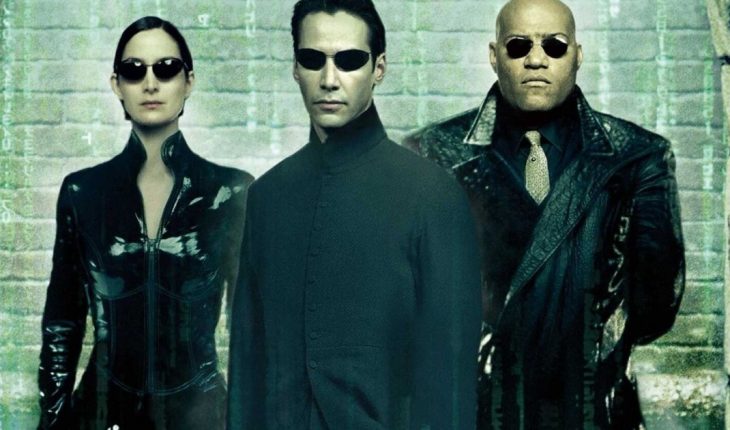Who didn’t get up one day believing that what he lived in dreams was really happening to him. With “The Matrix” (1999) sisters Lana and Lilly Wachowski shook the hornet and many of those bees that were there – and those that were back then – we stirred inside. To argue that reality is nothing more than a virtual simulation in which human beings remain connected to power machines was the beginning – or a popular starting point – of many issues that we constantly resign.
The Matrix, 1999
It may be a hasty analogy, but I think the path that traveled various waves of thought, movements and the process we call deconstruction today have to do with this awakening and defending what we believe we are beyond what we were always told. And just like this allegory, “The Matrix” is characterized by several.
It’s hard that after you’ve seen the movie, you forget about Neo (Keanu Reeves) choosing between the blue or red pill Morpheus (Laurence Fishburne) offers her, and if you haven’t seen her yet, the date and note are excuses for that. If you take the blue one, wake up again in your bed, and the feeling of change or knowing that there is more than what you feel every day disappears, returns to your work and just plays the role that touches you. If you choose the red one, “you stay in Wonderland and I’ll tell you how deep the hole is.” Did you decide? Of course, that every decision implies a renunciation, and the first thing Alice saw was not exactly the most pleasant but rather a universe of chaos and confusion; the parody of the society lewis Carroll wrote for 1860 London.
The Matrix, 1999
But let’s not be afraid. Because if there’s one thing about this film – coming out of two brilliant minds – it gives us a band of references and info constantly, from a modern version of Plato’s cavern allegory, to references to cinema and oriental manga, mythology (such as the “god of sleep” and the Oracle), eschatological details, and more. But it was also a success in many respects on an internet at birth, and a pop culture-loving audience awaiting not so much of this classic but of “Star Wars: Episode I – The Phantom Threat”, which did not return the astonishment of “The Matrix”; without the aim of comparing but of contextualizing an audience waiting for what was – with capital letters – THE premiere in terms of not only science fiction.
“We existed in a space where words did not exist and we always lived in the world of imagination (…). It all came from that same fire I’m talking about,” Lilly Wachowski.
Although these issues are quite spoken, it is always good to reiterate that the film is very interested both for its visual effects (the characteristic bullet time, which freezes the image as the camera moves), its reflections, script, photography and performances. But what value does “The Matrix” charge in today’s eyes? When everything seemed too much said around this film, one of the sister directors, Lilly Wachowski, acknowledged that the film is a “trans allegory,” and her words served as a flag for communities. From the micro, he revealed that the character Switch (Belinda McClory) is a woman in the Matrix, and a man in the world. From the macro, “when we talk about transformation, especially in science fiction everything revolves (…) in building different worlds and to the idea of what seems impossible becomes possible,” the filmmaker says in a note for Netflix (a platform on which the three films are located).
“The Matrix films, by the Wachowski sisters, were visibly trans beyond an allegorical level,” Diego Trerotola.
The directors were represented with their trans identities after the film’s release and that takes on interesting value that generates new perspectives on their cinema (composed not only of this luxury trilogy but of other productions such as “V of Revenge”, “Sense8”, and more), especially if we thought that on March 31 (but years later, 2009) would commemorate Transti Transti Visibility Day , aimed at reflecting on your rights and dreams. What’s changed since the premiere of “The Matrix,” and how do we think about it today?” Especially for my generation, people in their 30s who have seen the Wachowski sisters’ films, although at the time you didn’t understand the narrative of where I came from and you said ‘what good special effects’, knowing over time that these two wonderful people were behind and today doing that rereading is a ‘yes, yes, yes’. Obviously globally it is visible to have two great and well-known directors; the maestrea work is a great gift for the trans population,” Lautaro says of the date.
The Matrix, 1999
Lautaro Lucas Cruz is a fan of the film. In addition, he integrates the collective Brown Identity, is co-founder of Trans Argentinxs, and self-perishes as transmasculinity. He first saw her with a trans friend, also an admirer of the directors, and who was telling her the hidden details. “I think that by its time the plot was complicated, a lot of doors open to question and at a time when society was pushing it, at least in Argentina,” he reflects.” And seeing this in cinema, as well as families, schools and gardens having these debates is always a necessary result, because we are adults who set limits on children in terms of their identity, gender construction. That’s what the directors are aiming for: join in questioning, and think beyond what you see in the film,” she adds.
I just saw “The Matrix” for the first time in high school. My teaching sister added it to the content for her students. Discussions expand and “can be reread from the fact that wachoskis are represented as trans people.” Necessary meaning provided by Diego Trerotola, film critic, director of Festival Asterisco.” His films were visibly trans beyond an allegorical level. They worked with the other dimension, consciousness, sexuality. Sometimes sublimated but thinking the same and the strange, from a playful relationship you do want. They were hybrid because they had a lot of Asian aesthetics (the sensual, police and fantasy of that cinema), and they popularized it in America,” he explains. And it is such that trilogy in addition to science fiction honors elements of other genres as mentioned above. It has literature and action, it is a drama and at the same time a kind of dystopia; and its elements range from Japanese manga to being a precursor to the films that would honor her afterwards.
“It’s a trans narrative because it tells the transformation of the world, how unreal it is for some, and what you want to change from an oppressive system: you’re someone who acts differently and thinks differently than expected and you’re going to fight for it,” Lautaro Cruz.
“In ‘The Matrix’ there was a mystery that started at one and developed into the other two. By this I’m not saying that the trans is a mystery, but that they played with what I show and how. I think the relationship between Matrix and trans visibility has to do a little bit with that. It must be thought that visibility is not an obligation, nor a program. And this date suggests that each person has the right to show himself but also not to do so and that in both cases it is without any discrimination. Identity does not entail any kind of restriction,” he says. Whether it’s with consent or not, isn’t it? Interesting point to highlight as it was learned that the Daily Mail priced Lilly to publicly count her identity transition in an exclusive for them; testimony that the principal finally decided to share with Windy City Times. Already in the interview with Netflix, the filmmaker claims that her decisions were embodied in the film as each went their way: “We existed in a space where words did not exist and we always lived in the world of imagination (…). It all came from that same fire I’m talking about.”
Sisters Lilly and Lana Wachowski
“Just like Lilly’s speech that’s very important to the trans community has to do with that, with that was the moment she decided to tell it. It’s not about confessing anything but living freely,” Trerotola brings. For Diego, they themselves created a kind of myth within the shoots few people could see, “a cinematic Matrix, where reality and fiction were mixed. This other dimension of how they shot and how they became very successful filmmakers in this film that marked an entire generation.” The critic points this out because while the process of creating the first film coincided with Lana’s transition, they continued to unleash their authorial label that distinguished them so much. “They kept making the movies they wanted, and that’s important too. Not that before they became visible as trans people they had a style of their own and then changed it. In art they were always free, they created very personal films,” he reflects.
For Lautaro listening to Lilly it was a moment that recalls: “He invited me to see ‘Matrix’ again and I think he proposes to the generation of young people to continue to keep these great films, to rethink each day: where are we? What do we build being who we are? I like it… keep fighting, with the fears and pains it also shows.” So far we hadn’t done that reading of what a trans narrative is because it tells the transformation of the world, how unreal it is perhaps for some, how society works and what one wants to change from that society or an oppressive system: you are someone who acts differently and thinks differently than expected and you will fight for it. I’m thinking about it and it sounds like something real to me,” and that’s like thought or parentheses said out loud is everything.” That freed us up as filmmakers: imagining things you didn’t necessarily see on screen”
From her childhood Lana and Lilly Wachowski were attracted to comics, dungeons and dragons and role-playing games. Worlds in which nothing was limited, and one can build who she wants to be. In “The Matrix,” Neo is also Thomas Anderson. In one reality, a hacker, in another, a computer programmer. Like who says, at night Batman, or by day Bruce Wayne. The alter ego of a savior but at the same time the identity he finally adopts, since we remember, the Oracle does not tell him to be who Morpheus expects him to be, it is when he feels that he wants to be as Neo does not like the idea of not controlling his life. That geek audience or collective that in the 90s was on the rise but was still a niche, those kids or collective lovers of pop culture, role-playing games, comics, manga and what we would later see as cosplay (adopting the identity of the character) that they were beginning to meet, felt an arrow with “The Matrix”, feel that the cinema was watching them.
The Matrix, 1999
“Everything was mixed up,” says Diego Trerotola, “It also coincided with the advancement of the Internet, the first role-playing games, geek culture, nerd, gamer and cosplay, dressing up as superheroes and superheroes.’ Matrix’ talks a little bit about how to build identities, and about gender technology, which also comes from the feminist cyborg manifesto: all people are a bit of technologies and a bit human. Let’s think Carrie Anne Moss (Trinity) is a pretty androgenous person, as are the agents featured in the film. That created new ways to build identities and they are more fluid across the web.” Since his activism, Lautaro complements the fact that many trans young people, whom he accompanies from Trans Argentines, have told him: “I play Conter (Strike) or loL (League of Legends) with a name of someone who has no gender – “and yes, that’s where this idea that the directors had is replicated,” she adds.
The Matrix, 1999
“That’s why I was attracted to science fiction and fantasy and played Dungeons and Dragons, everything was about creating worlds and I think that freed us as filmmakers,” Lilly will say, “imagine things you didn’t necessarily see on screen.” From tributes to honorees
The first time Diego Trerotola saw “The Matrix” was in the cinema (and there is a celebration of hearing something like this in pandemic moments). “He referred me a lot to the cinema of David Cronenberg, a cinema that just works between hybridity between man and machine. At that time ‘M. Butterfly’ had been released working on the trans body. Maybe with a movie defect but ‘Matrix’ expanded what Cronenberg had already done in films like ‘The Fly’. Even at some point I’m saying I didn’t see it as something so original but I did take it a step further,” he says. And yes, loty, but there the important thing is popularity, because the Wachowskis oversized not only genres but their look of the world, and with it the style that black and waterproof lenses had. After its first installment, matrix had second “The Matrix Reloaded” and third part “The Matrix Revolutions” which both arrived in 2003, as well as a series of animatrix short films – with extra material. Currently the fourth part is in development keeping its directors and original cast, and its arrival on the billboards was delayed due to the epidemiological situation.
One won four Oscar Awards for Best Editing, Best Sound, Best Sound Editing and Best Visual Effects. And the rental (blockbuster phenomenon) made it a classic and cult film. Maybe it’s because of chance that the dates coincided, but not for nothing, I guess they say chances don’t exist. “The Matrix” does not age and is interesting in that step of time, rething it with perspectives of today, since the testimony of its authors, is faithful to its plot in which fighting for what is defended and believing it with conviction is the most important thing.
In this note:





